The Snapdragon 865 Performance Preview: Setting the Stage for Flagship Android 2020
by Andrei Frumusanu on December 16, 2019 7:30 AM EST- Posted in
- Mobile
- Qualcomm
- Smartphones
- 5G
- Cortex A77
- Snapdragon 865
System Performance
System performance on the QRD865 was a bit of a tricky topic, as we’ve seen that the same chipset can differ quite a lot depending on the software implementation done by the vendor. For the performance preview this year, Qualcomm again integrated a “Performance” mode on the test devices, alongside the default scheduler and DVFS behaviour of the BSP delivered to vendors.
There’s a fine line between genuine “Performance” modes as implemented on commercial devices such as from Samsung and Huawei, which make tunings to the DVFS and schedulers which increase performance while remaining reasonable in their aggressiveness, and more absurd “cheating” performance modes such as implemented by OPPO for example, which simply ramp up the minimum frequencies of the chip.
Qualcomm’s performance mode on the QRD865 is walking this fine line – it’s extremely aggressive in that it’s ramping up the chipset to maximum frequency in ~30ms. It’s also having the little cores start at a notably higher frequency than in the default mode. Nevertheless, it’s still a legitimate operation mode, although I do not expect very many devices to be configured in this way.
The default mode on the other hand is quite similar to what we’ve seen on the Snapdragon 855 QRD last year, but the issue is that this was also rather conservative and many popular devices such as the Galaxy S10 were configured to be more aggressive. Whilst the default config of the QRD865 should be representative of most devices next year, I do expect many of them to do better than the figures represented by this config.
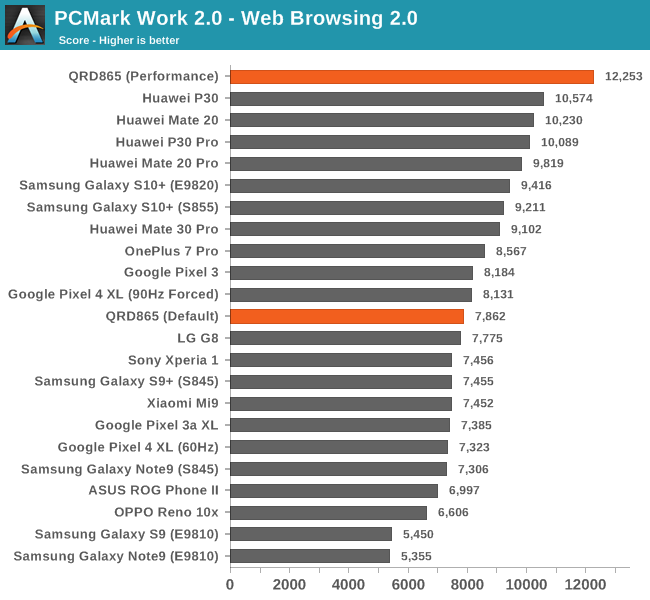
Starting off with the web browsing test, we’re seeing the big difference in performance scaling between the two chipsets. The test here is mostly sensible to the performance scaling of the A55 cores. The QRD865 in the default more is more conservative than some existing S855 devices, which is why it performs worse in those situations. On the other hand, the performance results of the QRD865 here are also extremely aggressive and receives the best results out there amongst our current device range. I expect commercial devices to fall in somewhere between the two extremes.
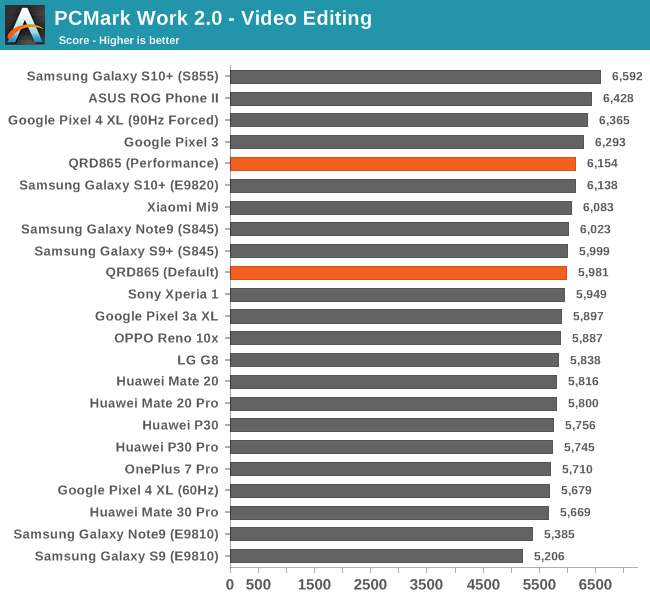
The video editing test nowadays is no longer performance sensitive and most devices fall in the same result range.
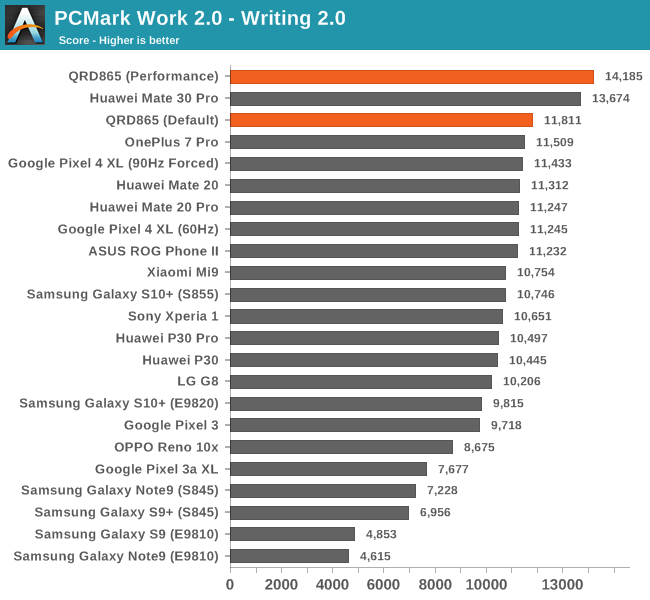
The writing test is amongst the most important and representative of daily performance of a device, and here the QRD865 does well in both configurations. The Mate 30 Pro with the Kirin 990 is the only other competitive device at this performance level.
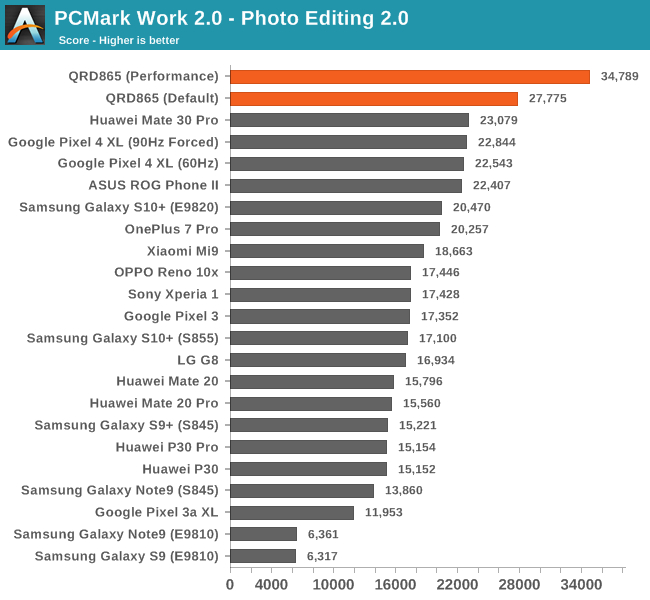
The Photo Editing test makes use of RenderScript and GPU acceleration, and here it seems the new QRD865 makes some big improvements. Performance is a step-function higher than previous generation devices.
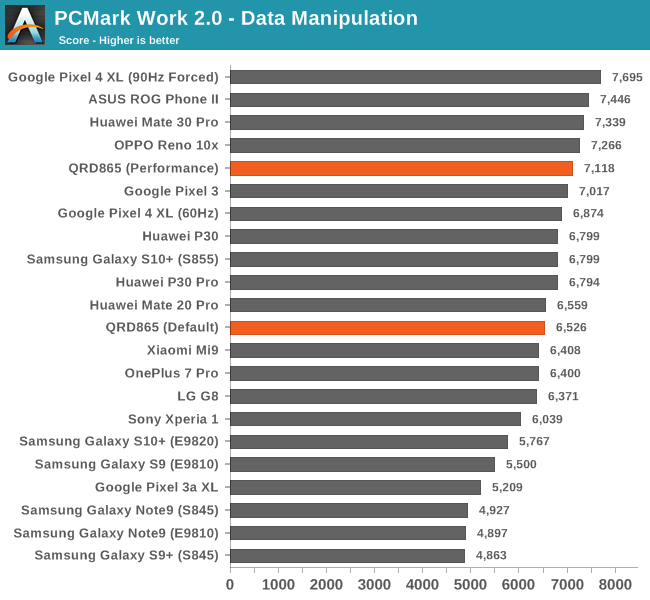
Finally, the data manipulation test oddly enough falls in middle of the pack for both performance modes. I’m not too sure as to why this is, but we’ve seen the test being quite sensible to scheduler or even OS configurations.
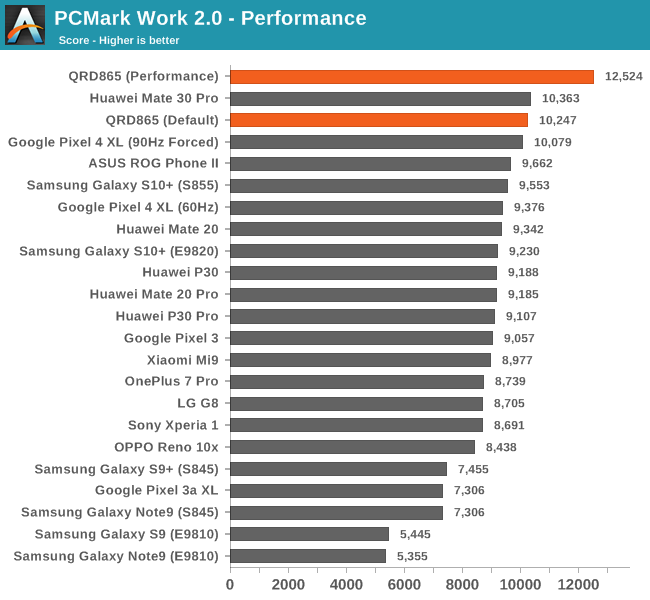
Generally, the QRD865 phone landed at the top of the rankings in PCMark.
Web Benchmarks

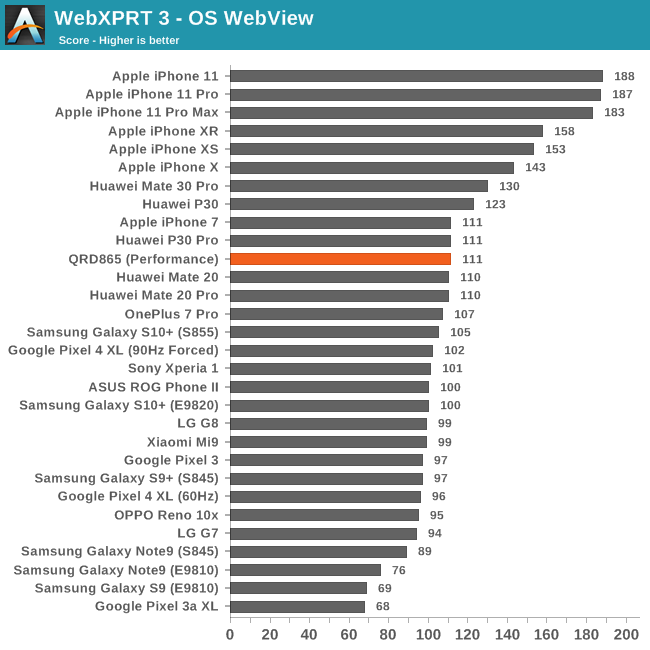
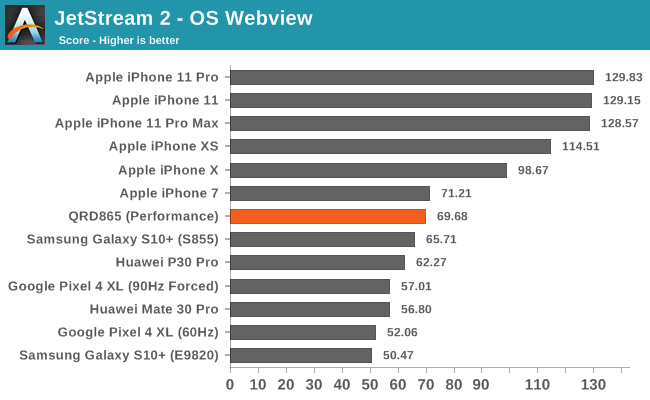
The web benchmarks results presented here were somewhat disappointing. The QRD865 really didn’t manage to differentiate itself from the rest of the Android pack even though it was supposed to be roughly 20-25% ahead in theory. I’m not sure what the limitation here is, but the 5-10% increases are well below what we had hoped for. For now, it seems like the performance gap to Apple’s chips remains significant.
System Performance Conclusion
Overall, we expect system performance of Snapdragon 865 devices to be excellent. Commercial devices will likely differ somewhat in terms of their scores as I do not expect them to be configured exactly the same as the QRD865. I was rather disappointed with the web benchmarks as the improvements were quite meagre – in hindsight it might be a reason as to why Arm didn’t talk about them at all during the Cortex-A77 launch.











178 Comments
View All Comments
UglyFrank - Monday, December 16, 2019 - link
I imagine the Tab S7 will have this.Meanwhile the iPad Pro 2020 will most likely have more than double the GPU power.
Kishoreshack - Monday, December 16, 2019 - link
That's not how it works broUglyFrank - Monday, December 16, 2019 - link
It is. The A12X has more than double the S855's GPU performance and we can expect ~ 20% increase in GPU performance (A12X to A13X) as the A12 to A13 had a similar increase.generalako - Monday, December 16, 2019 - link
Ok, but then again the SD875 (or whatever it will be called) is expected to be on a new architecture after 3 generation, which generally means 50%+ jump just there. With the transition over to 5nm, you can expect even more performance from that. That would, after all, be the most fair comparison to the A14 (or A14X) on 5nm later this year, due to process node comparisons. Same with CPUs (don't forget, the A77 in the SD865 was released in the summer before by ARM, and even presented in the SD865 in December).close - Tuesday, December 17, 2019 - link
Over the past few years Apple has been doing a consistently better job than Qualcomm regardless of process node. Probably they can afford to since they are in full control of the whole technology stack, including the software which means they can squeeze additional performance and efficiency like that. But this doesn't change the fact that year after year A-chips are better than their counterparts.tuxRoller - Wednesday, December 18, 2019 - link
I'm not sure that apple is much, if at all, more optimized than the Android bsps. If you're aware of proof to the contrary I'd be interested in reading it.michael2k - Wednesday, December 18, 2019 - link
It doesn’t mean optimized the way you envision it. It means more tailored to the design, since Apple has a fixed number of systems it has to support. There are three ways to see it: how many years does Apple push iOS updates? That is a function of performance as well, as as the OS.Another way to see it is knowing that Apple ships iPhones with much less RAM, meaning their OS and apps have to be designed to use less RAM too.
Likewise their iPhone usually ships with smaller batteries; by designing the OS, SoC, and RAM synergistically they can use a smaller battery too. RAM happens to use energy even when idle, so less RAM does translate to lower energy usage.
michael2k - Tuesday, December 17, 2019 - link
Yeah, but anything Qualcomm does to boost performance, Apple will be doing too.The 865 is going to compete with the A14 in 2020, and the 875 will compete with the A15 in 2021. So if we expect the A14 to boost perf by 15% and the A14X to boost perf by 40%, and the A15 to boost perf again by 10% and A15X to boost perf again by 25%, you'll see:
855 = 1.00
865 = 1.25
875 = 1.50
A13 = 1
A13X = 1.4
A14 = 1.15
A14X = 1.96
A15 = 1.26
A15X = 2.45
Technically Qualcomm has more room to improve when you compare transistor budgets: the A13 is approximately 8.5b transistors, the A12 7b transistors.
In comparison, the 855 only had 6b transistors, per Qualcomm itself:
https://www.qualcomm.com/media/documents/files/sna...
id4andrei - Tuesday, December 17, 2019 - link
The 865 competes with A13 not with the future A14. Apple sets the cadence in the SoC space and have done so since breaking rank with sheer performance and transition to a 64bit arch.generalako - Tuesday, December 17, 2019 - link
This is just misrepresentative. The past two generations ARM's architecture has been closing the gap to Apple. It closed the gap by around 30% in IPC with A76, and doing so by around 15% in IPC with A77 (A77 had 27% IPC gain vs. A13's 12% IPC gain). The gap has been getting smaller, and hopefully it will continue. But the fact is still that it's closing for the performance cores.Also, you're comparisons are way off. The SD855 was comparable to the A12, just as the SD865 is to the A13, and so on and so forth. This with process node and the actual release date of the Cortex Core in mind.